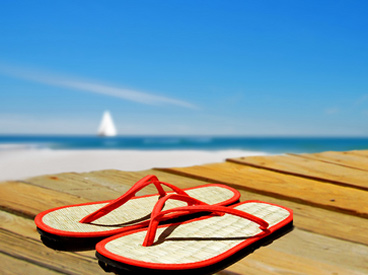 Flip-flops look and feel great at the beach and concerts in the park. But the relaxed footwear can strain muscles and aggravate nerves in the feet and ankles when worn too long or if playing sports.
Flip-flops look and feel great at the beach and concerts in the park. But the relaxed footwear can strain muscles and aggravate nerves in the feet and ankles when worn too long or if playing sports.
So go ahead and step out in your favorite flip-flops for summertime strolls and parties. (P.S. Be sure to protect your feet with sunscreen.) Then, step into well-cushioned shoes when walking on concrete or pavement and exercising to dodge painful problems, say Mount Sinai School of Medicine Orthopaedic doctors who treat an influx of flip flop injuries each summer. Here’s why!
Flip-flops offer limited support.
- People grip and hold flip-flops in place with their toes. Result: This motion changes the way you walk and can stress the toes, ankles, legs, hips, and back.
- Flat and flimsy shoe beds provide inadequate foot support for all-day wear. Result: Arch pain, plantar fasciitis, and nerve issues.
- Lack of shock absorption. Result: Pain in feet, legs, hips, and back.

Flip-flops offer limited coverage.
- Few people understand or think of the foot as a place where skin cancer can arise. Result: Foot melanoma can be deadly. Mount Sinai Podiatrist Dr. Bryan Markinson reports a sharp rise in foot melanoma among his patients. Alert to sandal wearers: Remember to apply sunscreen to your feet!
- Flip-flops leave toes and nails uncovered and unprotected. Result: Broken toes and toenails.
- Feet can roll off the shoe. Result: Cuts and infections.
Mount Sinai’s Leni and Peter W. May Department of Orthopaedics specializes in surgery of the foot and ankle, knee, hip, hand, elbow, shoulder, and spine; total joint replacement for knee, hip, foot, ankle, and shoulder; microvascular surgery; cancer surgery; and minimally invasive surgery.
Become a Saturday Evening Post member and enjoy unlimited access. Subscribe now



